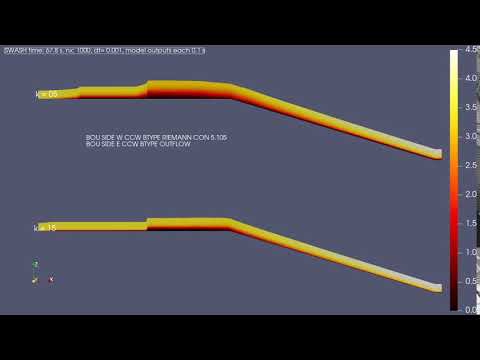Dear PARAVIEW community,
greetings. This is Marco, I am new here, recently started used this wonderful tool. I hope this email finds you all well.
I have a question regarding the creation of time-varying auxiliary curvilinear coordinates, that I’d like to append to a netcdf files. For pre-processing, I am using Python.
As an example, I am starting from the available netcdf inside the xarray package: https://xesmf.readthedocs.io/en/v0.1.2/Curvilinear_grid.html
When printing the array in Python (headers), I get:
Dimensions: (time: 36, x: 275, y: 205)
Coordinates: * time (time) datetime64[ns] 1980-09-16T12:00:00 1980-10-17 ...
xc (y, x) float64 189.2 189.4 189.6 189.7 189.9 190.1 190.2 190.4 ...
yc (y, x) float64 16.53 16.78 17.02 17.27 17.51 17.76 18.0 18.25 ...
Dimensions without coordinates: x, y
Data variables: Tair (time, y, x) float64 nan nan nan nan nan nan nan nan nan nan ...
In Python, I managed to mimic the structure of the file linked above. The field I am encapsulating into the newly-created netcdf file (in the example above: Tair) is timevarying but, unlike the example linked above, my xc, yc coordinates are timevarying too.
Instead of y, I am actually working over the vertical coordinate (x,z, time). So, when coding in python I added to zc (or yc in the original example) another dimension: time. Inside my for loop, when assigning Tair values for each timestep, I impose new yc coordinates too:
ds = xr.Dataset(
{
q2merge: ([ "time", "z", "x"], sal), #sal = salinity
},
coords={
"time": write_t_sereis(newt), #custom function to convert to time
"xc": (["time","z","x"], np.empty([nt, nz+1, nx],dtype='float32')),
"yc": (["time","z","x"], np.empty([nt, nz+1, nx],dtype='float32')), #------- as in CHapter 6.2. of http://cfconventions.org/cf-conventions/cf-conventions.html#discrete-axis
},
)#
#Start a time-marching loop and, at each time-step, append:
# - new vertical coordinates z
# - scalar field at timestep t
c= 0 # some counter
for thatStep in T:
yc[c,:,:] = Function_to_extract_zcoords(thatStep) # yc = yc(time, z, x)
# .....
# Add scalar field
ds[q2merge][c,:,:]=Function_to_extract_ScalarField(thatStep)
# .....
c = c +1
#Outside the loop, once done, append metadata:
ds['xc'].attrs['axis']="X"
ds['xc'].attrs['long_name']="longitude of grid cell center"
ds['xc'].attrs['units']="degrees_east"
#Should be vertical, Z, but it seems that PARAVIEW has a bug (see below)
ds['yc'].attrs['long_name']="latitude of grid cell center"
ds['yc'].attrs['units']="degrees_north"
ds.attrs['coordinates']="yc xc"
ds.close() #close the door when you leave
fname= "{}.nc".format(q2merge) #some meaningful name
ds.to_netcdf(fname, unlimited_dims={'time':True}) #flag as unlimited
However when I try post process that result (all t-steps in one file) in PV and visualize the results, vertical coordinates are not varying (here I call them “y”, but they are actually vertical, as PV seems to have a bug and fails in recognizing it. For the record, an issue was already posted: https://gitlab.kitware.com/vtk/vtk/-/issues/18035 ).
I tried saving all timesteps separately. In this case, I see that each time-step vertical structures preserves the desired structures (height of vertical levels), meaning that I can see the actual wire-frames fluctuating. However, when merging manually (with cdo or with nco), everything gets lost.
My questions:
-
does xarray allows time-varying auxiliary coordinates?
-
if so am I doing it correctly?
-
is the problem in my python code? or is PV not (yet?) able to understand time-varying coordinates?
If needed, I’d be happy to share my Python code as well as individual/merged netcdf files.
Thank you so much for the time you will dedicating to this.
